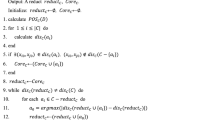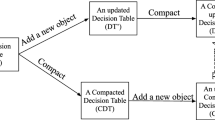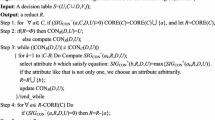Abstract
Attribute reduction is one of the issues in the rough set theory, and many reduction algorithms have been proposed to process the static decision systems. However, in real-life applications, the object may vary dynamically with time. In order to deal with common variations of the object (i.e., adding the object, deleting the object and modifying the object’s value) in the decision systems, the paper presents a unified incremental reduction algorithm for three types of the dynamic object from the viewpoint of the discernibility matrix. Firstly, the concepts of the equivalence class linked table (ECLT) and the simplified decision table are proposed. On the basis of ECLT, the incremental mechanisms are analyzed and the corresponding functions for updating the discernibility matrix are designed for three variations of the object. And then, the dynamic criterions how to add new attributes into the original reduct or delete redundant attributes from the original reduct are studied. Subsequently, a unified incremental reduction algorithm with varying the object is presented. A serial of experiments are validated to explain the feasibility and effectiveness of the proposed algorithms on different data sets from UCI.




Similar content being viewed by others
References
Chen HM, Li TR, Luo C et al (2014) A rough set-based method for updating decision rules on attribute values’ coarsening and refining. IEEE Trans Knowl Data Eng 26(12):2886–2899
Ge H, Li LS, Xu Y et al (2015) Bidirectional heuristic attribute reduction based on conflict region. Soft Comput 19(7):1973–1986
Hu XH, Cercone N (1995) Learning in relational databases a rough set approach. Int J Comput Intell 11(2):323–338
Hu QH, Yu DR (2004) Entropies of fuzzy indiscernibility relation and its operations. Int J Uncertain Fuzziness Knowl Based Syst 12(5):575–589
Hu F, Wang GY, Huang H, Wu Y (2005) Incremental attribute reduction based on elementary sets. In: Proceeding of the 10th international conference on rough sets, fuzzy sets, data mining and granular computing, Regina, Canada, vol 3641. LNCS, pp 185–193
Hu QH, Xie ZX, Yu DR (2007) Hybrid attribute reduction based on a novel fuzzy rough model and information granulation. Pattern Recogn 40:3509–3521
Huang CC, Tseng TL, Fan YN et al (2013) Alternative rule induction methods based on incremental object using rough set theory. Appl Soft Comput J 13(1):372–389
Jensen R, Shen Q (2004) Fuzzy-rough attribute reduction with application to web categorization. Fuzzy Sets Syst 141:469–485
Jensen R, Shen Q (2007) Fuzzy-rough sets assisted attribute selection. IEEE Trans Fuzzy Syst 15(1):73–89
Jerzy B, Slowinski R (2003) Incremental induction of decision rules from dominance-based rough approximations. Electron Notes Theor Comput Sci 84(4):40–51
Jing YG, Li TR, Huang JF et al (2016) A group incremental reduction algorithm with varying data values. Int J Intell Syst 32(9):900–925
Jing YG, Li TR, Fujita F et al (2017) An incremental attribute reduction approach based on knowledge granularity with a multi-granulation view. Inf Sci 411:23–38
Li F, Yin YQ (2009) Approaches to knowledge reduction of covering decision systems based on information theory. Inf Sci 179(11):1694–1704
Li TR, Ruan D, Geert W et al (2007) A rough sets based characteristic relation approach for dynamic attribute generalization in data mining. Knowl Based Syst 20(5):485–494
Liang JY, Mi JR, Wei W et al (2013) An accelerator for attribute reduction based on perspective of objects and attributes. Knowl Based Syst 44:90–100
Liang JY, Wang F, Dang CY et al (2014) A Group incremental approach to feature selection applying rough set technique. IEEE Trans Knowl Data Eng 26(2):294–308
Liu SH, Seng QJ, Wu B et al (2003) Research on efficient algorithms for rough set methods. Chin J Comput 26(5):524–529
Liu D, Li TR, Ruan D et al (2011) Incremental learning optimization on knowledge discovery in dynamic business intelligent systems. J Glob Optim 51(2):325–344
Luo C, Li TR, Yao YY (2017) Dynamic probabilistic rough sets with incomplete data. Inf Sci 417:39–54
Miao DQ, Hu GR (1999) A heuristic algorithm for reduction of knowledge. J Comput Res Dev 36(6):681–684
Miao DQ, Zhao Y, Yao YY et al (2009) Relative reducts in consistent and inconsistent decision tables of the Pawlak rough set model. Inf Sci 179:4140–4150
Pawlak Z (1982) Rough sets. Int J Comput Inf Sci 11:341–356
Shu WH, Qian WB (2015) An incremental approach to attribute reduction from dynamic incomplete decision systems in rough set theory. Data Knowl Eng 100:116–132
Shu WH, Shen H (2014a) Updating attribute reduction in incomplete decision systems with the variation of attribute set. Int J Approx Reason 55:867–884
Shu WH, Shen H (2014b) Incremental feature selection based on rough set in dynamic incomplete data. Pattern Recogn 47:3890–3906
Skowron A, Rauszer C (1992) The discernibility matrices and functions in information systems. In: Slowinski R (ed) Intelligent decision support, handbook of applications and advances of the rough sets theory. Kluwer Academic, Dordrecht, pp 331–362
Tsang ECC, Chen DG, Yeung DS et al (2008) Attribute reduction using fuzzy rough sets. IEEE Trans Fuzzy Syst 16(5):1130–1141
Wang F, Liang JY, Qian YH (2013a) Attribute reduction: a dimension incremental strategy. Knowl Based Syst 39:95–108
Wang F, Liang JY, Dang CY (2013b) Attribute reduction for dynamic data sets. Appl Soft Comput 13(1):676–689
Wei W, Wu XY, Liang JY et al (2018) Discernibility matrix based incremental attribute reduction for dynamic data. Knowl Based Syst 140:142–157
Xie XJ, Qian XL (2018) A novel incremental attribute reduction approach for dynamic incomplete decision systems. Int J Approx Reason 93:443–462
Xu ZY, Liu ZP, Yang BR et al (2006) A quick attribute reduction algorithm with complexity of max(O(\({\vert }\)C\({\vert }{\vert }\)U\({\vert }\)), O(\({\vert }\)C\({\vert }^{2}{\vert }\)U/C\({\vert }\))). Chin J Comput 29(3):611–615
Xu YT, Wang LS, Zhang RY (2011) A dynamic attribute reduction algorithm based on 0–1 integer programming. Knowl Based Syst 24(8):1341–1347
Yang M (2007) An incremental updating algorithm for attribute reduction based on improved discernibility matrix. Chin J Comput 30(5):815–822
Yang X, Li TR, Liu D et al (2017a) A unified framework of dynamic three-way probabilistic rough sets. Inf Sci 420:126–147
Yang X, Li TR, Fujita H et al (2017b) A unified model of sequential three-way decisions and multilevel incremental processing. Knowl Based Syst 134:172–188
Yao YY, Zhao Y (2009) Discernibility matrix simplification for constructing attribute reducts. Inf Sci 179:867–882
Zeng AP, Li TR, Liu D et al (2015) A fuzzy rough set approach for incremental feature selection on hybrid information systems. Fuzzy Sets Syst 258(1):39–60
Zhang JB, Li TR, Chen HM (2014) Composite rough sets for dynamic data mining. Inf Sci 257(4):81–100
Zheng Z, Wang GY, Wu Y (2004) A rough set and rule tree based incremental knowledge acquisition algorithm. Fundam Inf 59(2–3):299–313
Acknowledgements
This work has been partially supported by the Grants from the National Science Foundation of China (No. 61402005), the Anhui Provincial Natural Science Foundation (No. 1308085QF114, 1508085MF126), the outstanding young talent of Chuzhou University (No. 2013RC003) and by the fund from Initial Scientific Research of Chuzhou University (No. 2016qd07).
Author information
Authors and Affiliations
Corresponding author
Ethics declarations
Conflict of interest
The authors declare that there are no conflicts of interest.
Additional information
Communicated by V. Loia.
Publisher's Note
Springer Nature remains neutral with regard to jurisdictional claims in published maps and institutional affiliations.
Appendix A. Related proof of proposed theorems and propositions
Appendix A. Related proof of proposed theorems and propositions
1.1 Proof of Theorem 1
Proof
(1) Firstly, prove \(\hbox {Core}(C)\subseteq \hbox {Core}'(C)\). Only prove that \(\forall a\in \hbox {Core}(C)\), then \(a\in \hbox {Core}'(C)\).
Because of \(a\in \hbox {Core}(C)\), it follows that there exists \(x_{i}\in U\) which satisfies \(x_{i}\in \hbox {POS}_{C}(D)\) but \(x_{i}\notin \hbox {POS}_{C-\{a\}}(D)\), namely \(f(x_{i},C-\{a\})=f(x_{j},C-\{a\})\wedge f(x_{i},a)\ne f(x_{j},a)\wedge f(x_{i},D)\ne { f}(x_{j},D)\). Suppose \(x_{i}\in [x'_{i}]_{C}\) and \(x_{j}\in [x'_{j}]_{C}\), then \(f(x'_{i},C-\{a\})=f(x'_{j},C-\{a\})\wedge f(x'_{i},a)\ne f(x'_{j},a)\). Since \(x_{i}\in \hbox {POS}_{C}(D)\), then \(x'_{i}\in \hbox {POS}_{C}(D)\). \(x_{j}\) exists two cases: (i) \(x_{j}\in \hbox {POS}_{C}(D)\), then \(x'_{j}\in \hbox {POS}_{C}(D)\) and \(f(x'_{i},D)\ne { f}(x'_{j},D)\). From \(x'_{i}\), \(x'_{j}\in \hbox {POS}_{C}(D)\), we have \(x'_{i}\), \(x'_{j}\in U_{1}'\). We can attain \(m_{ij}=\{a\}\), then \(a\in \hbox {Core}'(C)\). (ii) \(x_{j}\notin \hbox {POS}_{C}(D)\), then \(x'_{j}\notin \hbox {POS}_{C}(D)\). Because of \(x'_{i}\in \hbox {POS}_{C}(D)\), from Definition 1, we can attain \(x'_{i}\in U_{1}'\) and \(x'_{j}\in U_{2}'\); from Definition 2 and Definition 3, we can attain \(m_{ij}=\{a\}\), then \(a\in \hbox {Core}'(C)\). Hence, \(a\in \hbox {Core}'(C)\).
(2) Secondly, prove \(\hbox {Core}'(C)\subseteq \hbox {Core}~(C)\). Only prove that \(\forall a\in \hbox {Core}'(C)\), then \(a\in \hbox {Core}(C)\).
Because of \(a\in \hbox {Core}'(C)\), it follows that there exists \(m_{ij}\in {{\varvec{M}}}\) and \(m_{ij}=\{a\}\), namely \(\exists \, x_{i}\), \(x_{j}\in U'\), \(f(x_{i},a)\ne f(x_{j},a)\wedge f(x_{i},C-\{a\})=f(x_{j},C-\{a\})\). At least \(\exists \, x_{i}\in U_{1}'\) or \(x_{j}\in U_{1}'\), suppose \(x_{i}\in U_{1}'\), then \(x_{i}\in \hbox {POS}_{C}(D)\). \(x_{j}\) exists two cases: (i) \(x_{j}\in U_{1}'\), then \(f(x_{i},a)\ne f(x_{j},a)\wedge f(x_{i},C-\{a\})=f(x_{j},C-\{a\})\wedge f(x_{i},D)\ne { f}(x_{j},D)\), so that \(x_{i}\notin \hbox {POS}_{C-\{a\}}(D)\). (ii) \(x_{j}\in U_{2}'\), suppose \(\exists \, x'_{j}\in [x_{j}]_{C}\), then \(f(x_{i},D)\ne { f}(x'_{j},D)\). Similarly (i), we can gain \(x_{i}\notin \hbox {POS}_{C-\{a\}}(D)\). From (i) and (ii) we can get \(\hbox {POS}_{C-\{a\}}(D)\ne \hbox {POS}_{C}(D)\), so that \(a\in \hbox {Core}(C)\).
From (1) and (2), Theorem 2 can be proved. \(\square \)
1.2 Proof of Theorem 2
Proof
First, we pove that \(R\subseteq C\) and \(R\in { RedM}\), then \(R\in { Red}\).
-
(1)
Firstly, prove \(\forall R\in { RedM}\), then \(\hbox {POS}_{R}(D)=\hbox {POS}_{C}(D)\).
Prove to the reverse. Suppose that \(\exists \, R\in { RedM}\) and \(\hbox {POS}_{R}(D)\ne \hbox {POS}_{C}(D)\), then at least \(\exists \, x_{i}\in U\) and \(x_{i}\in \hbox {POS}_{C}(D)\), but \(x_{i}\notin \hbox {POS}_{R}(D)\). According to Definition 1, then \(f(x_{i},D)\ne V_{\xi }'\). Since \(x_{i}\notin \hbox {POS}_{R}(D)\), we have \(\exists \, x_{j}\in U (x_{j}\ne x_{i})\) and \(f(x_{i},R)=f(x_{j},R)\wedge f(x_{i},D)\ne f(x_{j},D)\). \(x_{j}\) exists two cases: (i) \(x_{j}\in \hbox {POS}_{C}(D)\). From Definition 1, we can obtain \(f(x_{j},D)\ne V_{\xi }'\), and \(f(x_{i},R)=f(x_{j},R)\wedge f(x_{i},D)\ne f(x_{j},D)\). By Definition 4, we have \(R\cap m_{ij}=\varPhi \). (ii) \(x_{j}\notin \hbox {POS}_{C}(D)\). From Definition 1, we can have \(f(x_{j},D)=V_{\xi }'\), and \(f(x_{i},R)=f(x_{j},R)\wedge f(x_{i},D)\ne f(x_{j},D)\), then \(R\cap m_{ij}=\varPhi \). From (i) and (ii), we can get \(R\cap m_{ij}=\varPhi \), which is conflict with condition (1) of Definition 4. Therefore, the hypothesis is not valid and have \(\hbox {POS}_{R}(D)=\hbox {POS}_{C}(D)\).
-
(2)
Secondly, prove \(\forall R\in { RedM}\) and \(\forall a\in R\), then \(\hbox {POS}_{C}(D)\ne \hbox {POS}_{R-\{a\}}(D)\).
Prove to the reverse. Assume that \(R\in { RedM}\) and \(\exists \, a\in R\), there exists \(\hbox {POS}_{C}(D)=\hbox {POS}_{R-\{a\}}(D)\). From (1), we have \(\hbox {POS}_{R}(D)=\hbox {POS}_{C}(D)\), then \(\hbox {POS}_{R}(D)=\hbox {POS}_{R-\{a\}}(D)\). Because of \(\forall \varPhi \ne m_{ij}\in {{\varvec{M}}}\), \( R\cap m_{ij}\ne \varPhi \), so for \(x_{i},x_{j}\in U'\), we can obtain \(f(x_{i},R)\ne f(x_{j},R)\wedge f(x_{i},D)\ne f(x_{j},D)\), one of \(f(x_{i},D)\ne V_{\xi }'\) and \(f(x_{j},D)\ne V_{\xi }'\) holds at least. So we suppose \(f(x_{i},D)\ne V_{\xi }'\). There exist two cases for \(f(x_{j},D)\): (i) \(f(x_{j},D)\ne V_{\xi }\), then there necessarily exists \(f(x_{i},R)\ne f(x_{j},R) \wedge f(x_{i},D)\ne f(x_{j},D)\). (ii) \(f(x_{j},D)=V_{\xi }'\), there exists \(x'_{j}\in U\) and \(x'_{j}\in [x_{j}]_{C}\), but \(f(x_{j},D)\ne f(x'_{j},D)\), then one of \(f(x_{i},D)\ne f(x_{j},D)\) and \(f(x_{i},D)\ne f(x'_{j},D)\) holds at least. Suppose \(f(x_{i},D)\ne f(x_{j},D)\), there exists \(f(x_{i},R)\ne f(x_{j},R)\wedge f(x_{i},D)\ne f(x_{j},D)\). From (i) and (ii), we can have \(f(x_{i},R)\ne f(x_{j},R)\wedge f(x_{i},D)\ne f(x_{j},D)\). Since \(m_{ij}\) is arbitrary, then \(x_{i}\in \hbox {POS}_{R}(D)\). From \(\hbox {POS}_{R}(D)=\hbox {POS}_{R-\{a\}}(D)\), we can have \(x_{i}\in \hbox {POS}_{R-\{a\}}(D)\). From (i) and (ii), we know \(f(x_{i},D)\ne f(x_{j},D)\). In order to meet \(\hbox {POS}_{R}(D)=\hbox {POS}_{R-\{a\}}(D)\), there necessarily exists \(f(x_{i}\), \(R-\{a\})\ne f(x_{j},R-\{a\})\), and then have \(f(x_{i},R-\{a\})\ne f(x_{j},R-\{a\})\wedge f(x_{i},D)\ne f(x_{j},D)\), so \(R-\{a\}\cap m_{ij}\ne \varPhi \) which is conflict with condition (2) of Definition 4. Therefore, the hypothesis is not valid.
According to (1) (2), we can prove \(R\in { RedM}\), then \(R\in { Red}\)\(\square \)
Then, we prove that \(R\subseteq C\) and \(R\in { Red}\), then \(R\in { RedM}\).
Proof
(1) Firstly, prove \(\forall R\in { Red}\), then \(\forall \varPhi \ne m_{ij}\in {{\varvec{M}}}\) and \(R\cap m_{ij}\ne \varPhi \).
Prove to the reverse. Assume that there exists \(\varPhi \ne m_{ij}\in {{\varvec{M}}}\) and \(R\cap m_{ij}=\varPhi \), i.e., we have \(f(x_{i},R)=f(x_{j},R)\wedge f(x_{i},D)\ne f(x_{j},D)\). For \(x_{i}\), \(x_{j}\in U'\), one of \(f(x_{i},D)\ne V_{\xi }\) and \(f(x_{j},D)\ne V_{\xi }\) can hold at least. Suppose \(f(x_{i},D)\ne V_{\xi }\), we have \(x_{i}\in \hbox {POS}_{C}(D)\), and \(x_{j}\) exists the following two cases: (i) \(f(x_{j},D)\ne V_{\xi }'\), from Definition 1, there exists \(f(x_{i},R)=f(x_{j},R)\wedge f(x_{i},D)\ne f(x_{j},D)\) and then \(x_{i}\notin \hbox {POS}_{R}(D)\). (ii) \(f(x_{j},D)=V_{\xi }'\), suppose there exists \(x'_{j}\in U\), \(x'_{j}\in [x_{j}]_{C}\) and \(f(x_{j},D)\ne f(x'_{j},D)\), then one of \(f(x_{i},D)\ne f(x_{j},D)\) and \(f(x_{i},D)\ne f(x'_{j},D)\) will hold at least. Suppose \(f(x_{i},D)\ne f(x_{j},D)\), there exists \(f(x_{i},R)=f(x_{j},R)\wedge f(x_{i},D)\ne f(x_{j},D)\), we can have \(x_{i}\notin \hbox {POS}_{R}(D)\). From (i) and (ii), thus there exists \(x_{i}\), \(x_{i}\in \hbox {POS}_{C}(D)\), but \(x_{i}\notin \hbox {POS}_{R}(D)\), so \(\hbox {POS}_{R}(D)\ne \hbox {POS}_{C}(D)\), which is conflict with condition (1) of reduct definition. Therefore, the hypothesis is not valid.
(2) Secondly, prove \(\forall R\in { Red}\) and \(\forall a\in R\), then \(\exists \,\varPhi \ne m_{ij}\in {{\varvec{M}}}\), \(R-\{a\}\cap m_{ij}=\varPhi \).
Prove to the reverse. Assume that there exists \(a\in R\), \(\forall m_{ij}\ne \varPhi \) and \(m_{ij}\cap R-\{a\}\ne \varPhi \), i.e., we have \(f(x_{i},R-\{a\})\ne f(x_{j},R-\{a\})\wedge f(x_{i},D)\ne f(x_{j},D)\). One of \(f(x_{i},D)\ne V_{\xi }'\) and \(f(x_{j},D)\ne V_{\xi }'\) holds at least. Suppose \(f(x_{i},D)\ne V_{\xi }'\), then \(x_{j}\) exists the following two cases: (i) \(f(x_{j},D)\ne V_{\xi }'\). From Definition 1, we have \(f(x_{i},R-\{a\})\ne f(x_{j},R-\{a\})\wedge f(x_{i},D)\ne f(x_{j},D)\). (ii) \(f(x_{j},D)=V_{\xi }'\). There exists \(x'_{j}\in [x_{j}]_{C}\) and \(f(x_{j},D)\ne f(x'_{j},D)\), then one of \(f(x_{i},D)\ne f(x_{j},D)\) and \(f(x_{i},D)\ne f(x'_{j},D)\) will hold at least. Assume that \(f(x_{i},D)\ne f(x_{j},D)\), then we have \(f(x_{i},R-\{a\})\ne f(x_{j},R-\{a\})\wedge f(x_{i},D)\ne f(x_{j},D)\). From (i) and (ii), \(\forall x_{i}\), there necessarily exists \(f(x_{i},R-\{a\})\ne f(x_{j},R)\wedge f(x_{i},D)\ne f(x_{j},D)\). Since \(m_{ij}\) is arbitrary, then \(x_{i}\in \hbox {POS}_{R-\{a\}}(D)\).
From (1), we know \(\forall \varPhi \ne m_{ij}\in {{\varvec{M}}}\) and \(m_{ij}\cap R\ne \varPhi \), i.e., \(f(x_{i},R)\ne f(x_{j},R)\wedge f(x_{i},D)\ne f(x_{j},D)\). Thus, we can obtain \(x_{i}\in \hbox {POS}_{R}(D)\), so that \(\hbox {POS}_{R}(D)=\hbox {POS}_{R-\{a\}}(D)\), which is conflict with condition (2) of reduct definition. Therefore, the hypothesis is not valid.
According to (1) and (2), we can prove \(\forall R\subseteq C\) and \(R\in { Red}\), then \(R\in { RedM}\). \(\square \)
Hence, Theorem 2 holds.
Rights and permissions
About this article
Cite this article
Chuanjian, Y., Hao, G., Longshu, L. et al. A unified incremental reduction with the variations of the object for decision tables. Soft Comput 23, 6407–6427 (2019). https://doi.org/10.1007/s00500-018-3296-5
Published:
Issue Date:
DOI: https://doi.org/10.1007/s00500-018-3296-5




